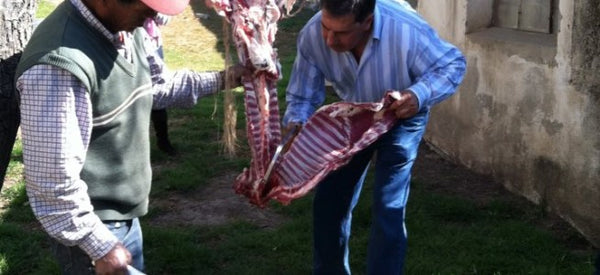
Meat in Mexico (Sheep Slaughter and Pig Processing)
By Janani Lee
Last year I visited Puebla, Mexico and had the opportunity to visit several farms, both industrial scale and independent. Meat is a cornerstone in Mexican cuisine, and though many families have difficulty affording it, it is still a strong cultural symbol in Mexican communities. During my trip I observed two radically different methods of raising and processing meat. The first was the sheep that was slaughtered for barbacoa in Tlaxcala, where we were witnessed the slaughter and breakdown of a sheep that was cooked using the traditional Mexican barbacoa methods. Seeing an animal transition from alive to meat and then raw meat to cooked meat all in the same location and at the hands of a few people is a rarity. The flock this sheep came from grazed in the hills surrounding the hacienda, eating local grasses and herbs that gave the meat its particular flavor. The sheep they choose to slaughter are between six months and two years old. I watched as the workers’ practiced hands held the sheep and pulled the knife through its throat and its blood drained into a pitcher. The animal was then strung up by its back legs; its skin, head, and front legs removed; and in less than twenty minutes it bore a closer resemblance to a piece of meat than a living animal. All parts of the animal were set aside for use – the head would go into the soup pot at the bottom of the barbacoa oven, the intestine that could be used for sausage casing, and even the blood would be cooked down or given to the dogs.
A few days later I visited the farm and processing facility of one of Mexico’s largest pork producers. The visit could not have contrasted more with the sheep slaughter I had just witnessed. The company’s vertical integration covers the milling of their pigs feed, breeding, raising, slaughter, processing, and selling in retail locations. Thousands of pigs live on the farm and are separated according to their function – breeding or fattening. There is a much greater detachment between the animals and the workers, and even though it is evident that the workers care about the health of the animals, the volume of pigs they are dealing with makes an individual connection impossible. Though I was prepared to witness the factory farm horrors I had read about in the past, I was surprised to find that the farm facilities looked clean and well maintained. The pigs were packed in tight, the sides of the feeding sheds rolled up and they got plenty of sunlight and ventilation.
After the pigs have gone through four successive stages of fattening, they are moved to a slaughterhouse, then their carcasses are moved to the processing facility which they leave in the packaged form that is a familiar sight in supermarkets. These facilities were also clean and well maintained, but I don’t know if I can ever forget the sight of hundreds of pigs flying in on conveyer belts as dozens of workers hacked at them with saws and butchers knives. The whole process look mechanically efficient and it was difficult to connect these carcasses with the living animals I had seen on the farm.
Though one company is overseeing this whole process, it is interesting to compare the number of times their pigs are moved throughout their lives and deaths and the number of hands involved in their slaughters and processing compared to the two workers that killed and prepared the sheep in Tlaxcala. The industrial, vertical system is what makes meat affordable in Mexico, but it also removes any personal connection with the animals.
Though there are multiple differences between the Mexican meat industries, it is important to think about the difference between industrial meat and farm-raised meat. It is important to think about the number of times something you eat has changed hands and been shipped from place to place. Shortening those supply chains makes for a healthier and more sustainable food system.
